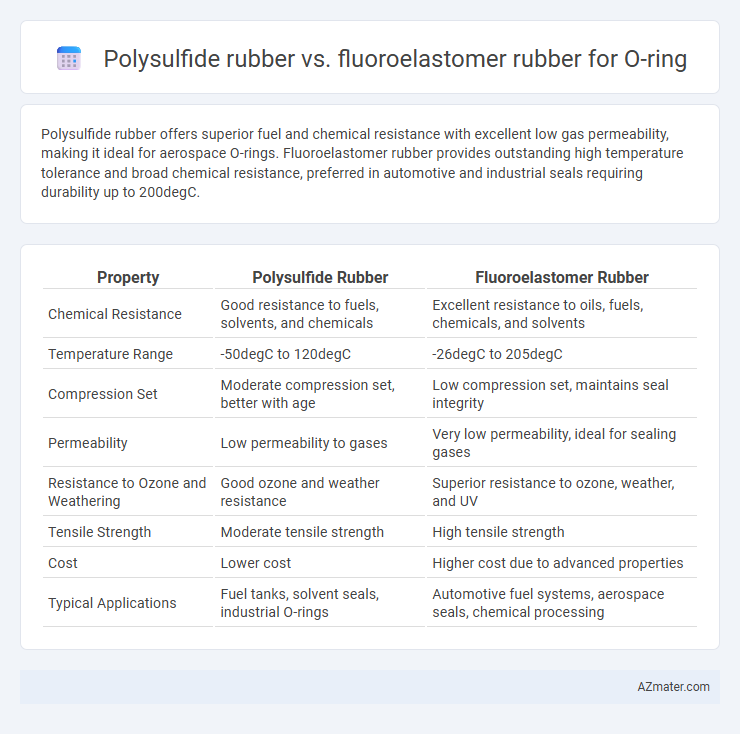Polysulfide rubber offers superior fuel and chemical resistance with excellent low gas permeability, making it ideal for aerospace O-rings. Fluoroelastomer rubber provides outstanding high temperature tolerance and broad chemical resistance, preferred in automotive and industrial seals requiring durability up to 200degC.
Table of Comparison
| Property | Polysulfide Rubber | Fluoroelastomer Rubber |
|---|---|---|
| Chemical Resistance | Good resistance to fuels, solvents, and chemicals | Excellent resistance to oils, fuels, chemicals, and solvents |
| Temperature Range | -50degC to 120degC | -26degC to 205degC |
| Compression Set | Moderate compression set, better with age | Low compression set, maintains seal integrity |
| Permeability | Low permeability to gases | Very low permeability, ideal for sealing gases |
| Resistance to Ozone and Weathering | Good ozone and weather resistance | Superior resistance to ozone, weather, and UV |
| Tensile Strength | Moderate tensile strength | High tensile strength |
| Cost | Lower cost | Higher cost due to advanced properties |
| Typical Applications | Fuel tanks, solvent seals, industrial O-rings | Automotive fuel systems, aerospace seals, chemical processing |
Introduction to Polysulfide and Fluoroelastomer Rubbers
Polysulfide rubber offers excellent chemical resistance and flexibility, making it ideal for O-rings in fuel systems and solvent exposure. Fluoroelastomer rubber, known for superior heat resistance and resistance to aggressive chemicals, excels in high-temperature and harsh chemical environments. Both materials ensure durable sealing performance with distinct advantages depending on the application's thermal and chemical demands.
Chemical Composition and Structure Comparison
Polysulfide rubber features a backbone composed of alternating sulfur and carbon atoms, providing excellent resistance to fuels, oils, and solvents due to its high sulfur cross-link density. Fluoroelastomer rubber consists primarily of fluorinated carbon chains, such as vinylidene fluoride and hexafluoropropylene units, which grant superior chemical resistance to aggressive chemicals, high temperatures, and ozone. The densely fluorinated molecular structure of fluoroelastomers enhances impermeability and thermal stability compared to the more flexible sulfur-based polysulfide matrix, making fluoroelastomers ideal for demanding sealing applications involving harsh chemicals.
Key Mechanical Properties of Each Rubber Type
Polysulfide rubber offers excellent flexibility and high tear resistance, making it suitable for O-rings exposed to dynamic stresses and moderate chemical environments. Fluoroelastomer rubber stands out with superior chemical resistance, high temperature tolerance up to 200degC, and excellent compression set resistance, ideal for sealing applications in aggressive fluids and extreme conditions. While polysulfide provides better elongation and resilience, fluoroelastomer excels in long-term durability and resistance to oils, fuels, and solvents.
Temperature Resistance: Polysulfide vs Fluoroelastomer
Polysulfide rubber O-rings exhibit temperature resistance typically ranging from -40degC to 120degC, making them suitable for moderate thermal environments. Fluoroelastomer O-rings offer superior heat resistance, functioning effectively between -26degC and 204degC, ideal for high-temperature applications. The higher thermal stability of fluoroelastomers ensures enhanced durability and performance in extreme heat compared to polysulfide alternatives.
Chemical Compatibility and Environmental Resistance
Polysulfide rubber O-rings exhibit excellent chemical resistance to polar solvents, oils, and fuels but have limited resistance to strong acids and bases, while fluoroelastomer O-rings offer superior chemical compatibility with a wide range of aggressive chemicals, including hydrocarbons, acids, and fuels. Fluoroelastomers provide exceptional environmental resistance, with high-temperature stability, excellent ozone, UV, and weathering resistance, and low gas permeability, outperforming polysulfide rubber in harsh conditions. Polysulfide elastomers are more susceptible to degradation from heat and oxidative environments, making fluoroelastomer O-rings the preferred choice for demanding chemical and environmental applications.
Applications and Industry Use Cases
Polysulfide rubber O-rings excel in fuel and solvent resistance, making them ideal for aerospace fuel systems and petrochemical applications where exposure to hydrocarbons is frequent. Fluoroelastomer rubber O-rings provide superior high-temperature stability and chemical resistance, commonly integrated into automotive engines, chemical processing equipment, and pharmaceutical manufacturing to withstand aggressive fluids and extreme thermal conditions. Both materials are crucial in sealing solutions but are selected based on specific chemical compatibility and temperature requirements across industries.
Performance in Sealing and O-Ring Longevity
Polysulfide rubber offers excellent chemical resistance and flexibility, making it highly effective for sealing applications exposed to fuels and solvents, with good ozone and weather resistance supporting long O-ring longevity. Fluoroelastomer rubber provides superior heat resistance up to 200degC and exceptional chemical inertness against oils, acids, and hydrocarbons, which enhances sealing performance in harsh industrial environments and extends O-ring service life significantly. The choice between polysulfide and fluoroelastomer O-rings depends on operating temperature, chemical exposure, and required durability, with fluoroelastomers generally delivering longer-lasting seals under extreme conditions.
Cost Analysis and Availability
Polysulfide rubber offers a lower cost and wider availability compared to fluoroelastomer rubber, making it a cost-effective choice for standard O-ring applications. Fluoroelastomer rubber, although significantly more expensive, provides superior chemical resistance and durability, which can reduce long-term replacement costs despite higher initial investment. Availability of fluoroelastomer O-rings is more limited and subject to supply chain fluctuations, while polysulfide O-rings are commonly stocked and easier to source globally.
Installation, Maintenance, and Replacement Considerations
Polysulfide rubber O-rings offer excellent chemical resistance and flexibility, making installation straightforward with minimal lubrication required, while their resistance to solvents reduces maintenance frequency. Fluoroelastomer O-rings, favored for high-temperature and aggressive chemical environments, require careful handling during installation to avoid damage due to their stiffness and sensitivity to ozone. Replacement of polysulfide O-rings is often simpler due to their resilience in dynamic sealing applications, whereas fluoroelastomer O-rings, despite longer service life, demand precise sizing and thorough inspection to ensure seal integrity.
Choosing the Right Rubber: Polysulfide or Fluoroelastomer for O-Rings
Polysulfide rubber offers excellent fuel and chemical resistance, making it ideal for sealing applications exposed to aviation fuels and solvents, with a temperature range typically from -40degC to 120degC. Fluoroelastomer rubber (FKM) excels in high-temperature environments up to 200degC and provides superior resistance to oils, fuels, and aggressive chemicals, ensuring durability in automotive and aerospace O-ring applications. Selecting between polysulfide and fluoroelastomer O-rings depends on the specific chemical exposure, temperature demands, and mechanical stress requirements of the sealing environment.

Infographic: Polysulfide rubber vs Fluoroelastomer rubber for O-ring
 azmater.com
azmater.com